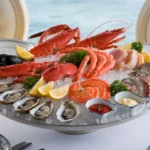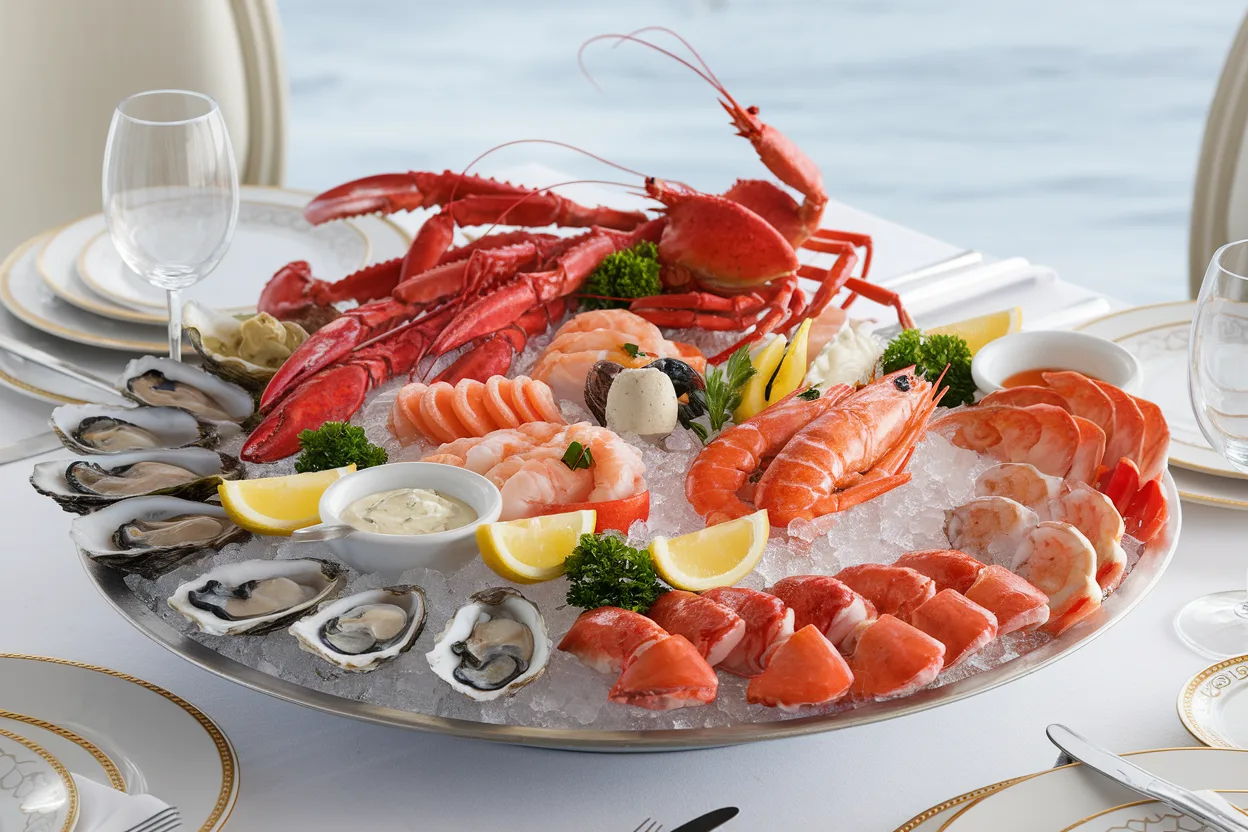Seafood Platters Recipe
If you’re ready to impress at your next gathering, this Seafood Platters Recipe is your ticket to a show-stopping feast! Imagine a chilled tray piled high with juicy shrimp, succulent crab legs, fresh oysters, and tender lobster tails—all beautifully arranged with zesty sauces and lemon wedges. Whether you’re hosting a fancy dinner party, celebrating a holiday, or just craving a luxurious seafood indulgence, this platter brings that ocean-fresh magic straight to your table. Trust me, it’s the kind of spread that’ll have everyone talking—and reaching for seconds! 🦞🍤🌊
Why You’ll Love This Recipe
- Elegant and Impressive: A visually stunning centerpiece that’s perfect for entertaining.
- Fresh and Flavorful: Packed with a variety of fresh seafood and bold, tangy dipping sauces.
- Customizable: Build your dream platter with your favorite seafood choices.
- Effortless Luxury: Looks fancy but is surprisingly easy to prepare—no need to be a professional chef!
Ingredients
Here’s what you’ll need to create the ultimate seafood platter experience:
- Cooked Shrimp: Sweet and juicy, perfect for dipping in cocktail sauce.
- Crab Legs: Rich and buttery, a luxurious highlight of the platter.
- Oysters on the Half Shell: Fresh and briny, served chilled with lemon.
- Lobster Tails: Tender and sweet, adding a touch of decadence.
- Smoked Salmon: Silky and rich with a savory, smoky flavor.
- Scallops: Light and tender, perfect when seared or served chilled.
- Mussels or Clams: A delicate and flavorful addition.
- Lemon Wedges: For a bright, citrusy kick that enhances every bite.
- Fresh Herbs: Parsley, dill, or chives for a burst of color and freshness.
- Cocktail Sauce: Tangy and classic for shrimp and crab.
- Garlic Butter Sauce: Ideal for lobster and crab legs.
- Tartar Sauce: Creamy and zesty, great for fried or chilled seafood.
- Ice and Garnishes: Crushed ice keeps everything cool and fresh, while decorative lemon slices add visual appeal.
Note: Ingredients with measurements will be listed below in the recipe card.
How to Make the Seafood Platters
Step 1: Prepare the Seafood
Make sure all seafood is cleaned and cooked as needed. Chill everything in the fridge before assembling the platter—cold seafood tastes best for this recipe!
Step 2: Shuck the Oysters
If using oysters, carefully shuck them and place them on half-shells. Arrange them over ice to keep them fresh and chilled until serving time.
Step 3: Make Your Sauces
Prepare your dips—cocktail sauce, garlic butter, and tartar sauce. Feel free to experiment with additional dips like aioli or lemon herb vinaigrette for variety.
Step 4: Assemble the Platter
Cover a large serving tray with a layer of crushed ice. Arrange your seafood in sections, grouping similar items together for an eye-catching presentation. Scatter lemon wedges and fresh herbs throughout the platter.
Step 5: Garnish and Serve
Add a final touch by garnishing with extra lemon slices and herbs. Serve immediately while everything is cold and fresh.
Pro Tips for Making the Recipe
- Buy Fresh Seafood: Always source your seafood from a reputable market for the best taste and quality.
- Keep It Chilled: Serve the platter over crushed ice to keep seafood cold and fresh.
- Mix It Up: Include a variety of seafood—some raw, some cooked—for an exciting range of textures and flavors.
- Add a Touch of Spice: Sprinkle a little Old Bay seasoning on shrimp or crab legs for extra flavor.
How to Serve
Here are some fun ways to elevate your seafood platter experience:
- Elegant Presentation: Serve on a large tray or platter with plenty of crushed ice to keep everything chilled.
- With Sides: Pair with crusty bread, garlic butter toast, or a fresh green salad for a complete meal.
- Perfect Pairing: Serve with a crisp white wine like Sauvignon Blanc or a refreshing sparkling rosé.
- Garnish Ideas: Add thinly sliced cucumbers, cherry tomatoes, or radishes for extra color and crunch.
Make Ahead and Storage
Storing Leftovers
Place any leftover seafood in an airtight container in the refrigerator. Most seafood will stay fresh for up to 2 days.
Freezing
You can freeze cooked seafood for up to 2 months. However, raw oysters and some shellfish don’t freeze well and are best enjoyed fresh.
Reheating
Gently reheat cooked seafood in the oven at 300°F (150°C) or in a steamer. Avoid reheating raw seafood—it’s best served chilled.
FAQs
What types of seafood are best for a platter?
A perfect seafood platter includes a mix of shellfish (like shrimp, crab, lobster, oysters) and smoked fish (like salmon). You can also add scallops, mussels, or clams for variety.How do I keep the seafood fresh on a platter?
Use crushed ice as the base of your platter to keep everything chilled. You can also serve in batches if the event lasts a long time to ensure freshness.Can I prepare the seafood platter ahead of time?
Yes! Cook and chill your seafood in advance, but assemble the platter just before serving to maintain freshness and presentation.What sauces pair best with seafood?
Classic cocktail sauce, garlic butter, and tartar sauce are must-haves. You can also try a lemon-dill yogurt sauce, spicy aioli, or a creamy remoulade for extra variety.
This Seafood Platters Recipe is a true celebration of the ocean’s bounty—fresh, luxurious, and perfect for making any occasion feel extra special. Whether you’re hosting a summer party, celebrating a holiday, or just treating yourself, this seafood platter is sure to impress every guest at your table! 🌊🦐🦞

Best Sauces and Dips for Seafood Platters
Description
Dive into a luxurious and refreshing Seafood Platter—a show-stopping centerpiece perfect for special occasions or casual gatherings. Featuring a delightful assortment of fresh seafood like shrimp, oysters, crab legs, and mussels, this platter is served chilled on a bed of ice with zesty lemon wedges, cocktail sauce, and creamy aioli. It’s simple to prepare and guaranteed to impress every seafood lover at the table!
Ingredients
Seafood Assortment:
- 1 lb cooked shrimp, peeled and deveined
- 1 lb king crab legs, cooked and split
- 1 dozen fresh oysters, shucked
- 1 lb cooked lobster tails, halved
- 1 lb mussels, steamed
- 1 lb clams, steamed
- 1 cup smoked salmon slices
Garnishes and Extras:
- Lemon wedges
- Fresh parsley
- Crushed ice for serving
Dipping Sauces:
- 1 cup cocktail sauce
- 1/2 cup garlic aioli
- 1/2 cup melted butter
- 1/2 cup tartar sauce
Instructions
Prepare the Base:
- Cover a large serving tray with crushed ice to keep the seafood chilled.
Cook the Seafood:
- Steam mussels and clams until they open (about 5 minutes). Discard any that don’t open.
- Boil the lobster tails and king crab legs for about 8–10 minutes or until heated through.
Arrange the Seafood:
- Neatly arrange shrimp, crab legs, oysters, lobster tails, mussels, clams, and smoked salmon on the tray over the ice.
Add Garnishes:
- Garnish with fresh lemon wedges and sprinkle chopped parsley on top.
Serve with Sauces:
- Place dipping sauces in small bowls and arrange them around the platter.
Chill & Serve:
- Keep the platter chilled until ready to serve for maximum freshness.
Notes
- Use only the freshest seafood for the best flavor.
- You can customize the platter by adding scallops, octopus, or other seafood varieties.
- Add edible seaweed for an elegant touch.
- Pair with a crisp white wine or sparkling beverage for a luxurious dining experience.

